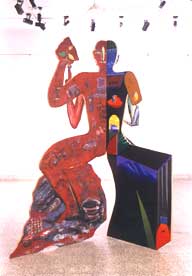|
|
Shanthamani |
Shanthamani's work is
a conscious departure from personal narratives and the 'Expressionist idiom'. Evolving a
language, with an arrangement of dissimilar objects and materials, she desires to preserve
the resonance of the found objects, from which we have been estranged. These fragmented
mechanical parts arouse her curiosity, in the artifice of a landscape of industry - the
human figure moving away, leaving traces of the human presence. She focuses on the
industrial landscape of urban 'gujalis' (junk yards), and absorbs the textures, shapes and
sounds at a ship breaking yard. These sites offer the artist a host of mechanical ruins,
that provide clues to an understanding of the mechanisation of our lives. Ironically,most
of these spare parts' and machines have become |
|
obsolete, with technological innovation. These materials are substandard,
irreparable and irreplaceable. Our economics urge us to buy more, waste more, throw away
more - we are not ecologically responsible.
|

|
Scientific
paradigm has reduced our universe into a well organised machine. Nature becomes an object
- a mere mechanism. We live in a world of dead matter. The machine then becomes a
metaphor. We are confronted with the comparison of the human body and the nation as a
mechanism, and the breaking down and building up of these structures.
The artist fractures her objects from their original functional state, and smoothes their
sharp edges to reconstruct another reality. She faces the debris as an aftermath of
violence, constructing her canvas with gestural delineation and heavy impasto, creating a
multitude of tactile sensations.
Working against the use of conventional materials, she metaphorically employs a range of
industrial substances like red oxide, synthetic distemper and paper pulp. This exploration
of technique and her experience of working in three dimension, gives her the confidence to
sculpt objects in given space. |
|
|
|
She is in the process of mapping and installing these objects as still lifes in a
landscape. These components are used like fetishes or toys, achieving a monumentality that
grows beyond human scale and control. The viewer is diminished and overpowered by her
statement. This ritual of play becomes a surreal experience in the realm of an uncertain
anxiety.
This struggle seeks to emphasise a human presence and tactile sensibility, heralding the
return of the hand from exile, in to her mechanical world. It is an attempt to return the
spiritual to the material : the search of stating a feminine presence in finding an order
in chaos.
|
| BIODATA |
| M. Shanthamani |
Born in 1967, Mysore
B.F.A. in painting in CAVA, Mysore 1983-88
M.F.A. in painting, M.S.. University, Baroda,
1989-91
Inlaks Take-off Grant, 1991-92
|
| Workshops and Camps |
Participated in South Zone Young Artist Camp, Mysore, 1992
IPCL Artist Camp, Nagothane, Maharashtra, 1992
|
| Exhibitions |
Karnataka Lalit Academy Annual Exhibition 1987, 1994 'SAHAMAT' Artists
against Communalism, 1990 A Solo Exhibition of Paintings at Jehangir Art Gallery,
Mumbai, 1994 Participated in the group exhibition 'The Silence of Furies and Sorrows' with
five artists in 1995
Participated in the group exhibition 'Immaterial Material' organised by Max Mueller
Bhavan, Bangalore in 1995
Currently living and working in Bangalore.
|
|
|

